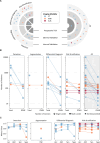Artificial intelligence in pancreatic intraductal papillary mucinous neoplasm imaging: A systematic review
- PMID: 40700385
- PMCID: PMC12286379
- DOI: 10.1371/journal.pdig.0000920
Artificial intelligence in pancreatic intraductal papillary mucinous neoplasm imaging: A systematic review
Abstract
Based on the Fukuoka and Kyoto international consensus guidelines, the current clinical management of intraductal papillary mucinous neoplasm (IPMN) largely depends on imaging features. While these criteria are highly sensitive in detecting high-risk IPMN, they lack specificity, resulting in surgical overtreatment. Artificial Intelligence (AI)-based medical image analysis has the potential to augment the clinical management of IPMNs by improving diagnostic accuracy. Based on a systematic review of the academic literature on AI in IPMN imaging, 1041 publications were identified of which 25 published studies were included in the analysis. The studies were stratified based on prediction target, underlying data type and imaging modality, patient cohort size, and stage of clinical translation and were subsequently analyzed to identify trends and gaps in the field. Research on AI in IPMN imaging has been increasing in recent years. The majority of studies utilized CT imaging to train computational models. Most studies presented computational models developed on single-center datasets (n = 11,44%) and included less than 250 patients (n = 18,72%). Methodologically, convolutional neural network (CNN)-based algorithms were most commonly used. Thematically, most studies reported models augmenting differential diagnosis (n = 9,36%) or risk stratification (n = 10,40%) rather than IPMN detection (n = 5,20%) or IPMN segmentation (n = 2,8%). This systematic review provides a comprehensive overview of the research landscape of AI in IPMN imaging. Computational models have potential to enhance the accurate and precise stratification of patients with IPMN. Multicenter collaboration and datasets comprising various modalities are necessary to fully utilize this potential, alongside concerted efforts towards clinical translation.
Copyright: © 2025 Qadir et al. This is an open access article distributed under the terms of the Creative Commons Attribution License, which permits unrestricted use, distribution, and reproduction in any medium, provided the original author and source are credited.
Conflict of interest statement
I have read the journal's policy and the authors of this manuscript have the following competing interests: FRK declares unpaid advisory roles for Perspectum, Inc., Oxford, UK; Radical Healthcare, Inc., San Francisco, CA; and the Surgical Data Science Collective (SDSC), Washington, DC. CMS declares an unpaid advisory role for Perspectum, Inc., Oxford, UK. All other authors declare no competing interests.
Figures



Update of
-
Artificial Intelligence in Pancreatic Intraductal Papillary Mucinous Neoplasm Imaging: A Systematic Review.medRxiv [Preprint]. 2025 Jan 9:2025.01.08.25320130. doi: 10.1101/2025.01.08.25320130. medRxiv. 2025. Update in: PLOS Digit Health. 2025 Jul 23;4(7):e0000920. doi: 10.1371/journal.pdig.0000920. PMID: 39830259 Free PMC article. Updated. Preprint.
Similar articles
-
Artificial Intelligence in Pancreatic Intraductal Papillary Mucinous Neoplasm Imaging: A Systematic Review.medRxiv [Preprint]. 2025 Jan 9:2025.01.08.25320130. doi: 10.1101/2025.01.08.25320130. medRxiv. 2025. Update in: PLOS Digit Health. 2025 Jul 23;4(7):e0000920. doi: 10.1371/journal.pdig.0000920. PMID: 39830259 Free PMC article. Updated. Preprint.
-
Application of Artificial Intelligence in Pancreatic Cyst Management: A Systematic Review.Cancers (Basel). 2025 Aug 2;17(15):2558. doi: 10.3390/cancers17152558. Cancers (Basel). 2025. PMID: 40805252 Free PMC article. Review.
-
Artificial intelligence for diagnosing exudative age-related macular degeneration.Cochrane Database Syst Rev. 2024 Oct 17;10(10):CD015522. doi: 10.1002/14651858.CD015522.pub2. Cochrane Database Syst Rev. 2024. PMID: 39417312
-
Association of high-risk stigmata and worrisome features with advanced neoplasia in intraductal papillary mucinous neoplasms (IPMN): A systematic review.Pancreatology. 2024 Feb;24(1):48-61. doi: 10.1016/j.pan.2023.12.002. Epub 2023 Dec 7. Pancreatology. 2024. PMID: 38161091
-
Signs and symptoms to determine if a patient presenting in primary care or hospital outpatient settings has COVID-19.Cochrane Database Syst Rev. 2022 May 20;5(5):CD013665. doi: 10.1002/14651858.CD013665.pub3. Cochrane Database Syst Rev. 2022. PMID: 35593186 Free PMC article.
References
LinkOut - more resources
Full Text Sources
